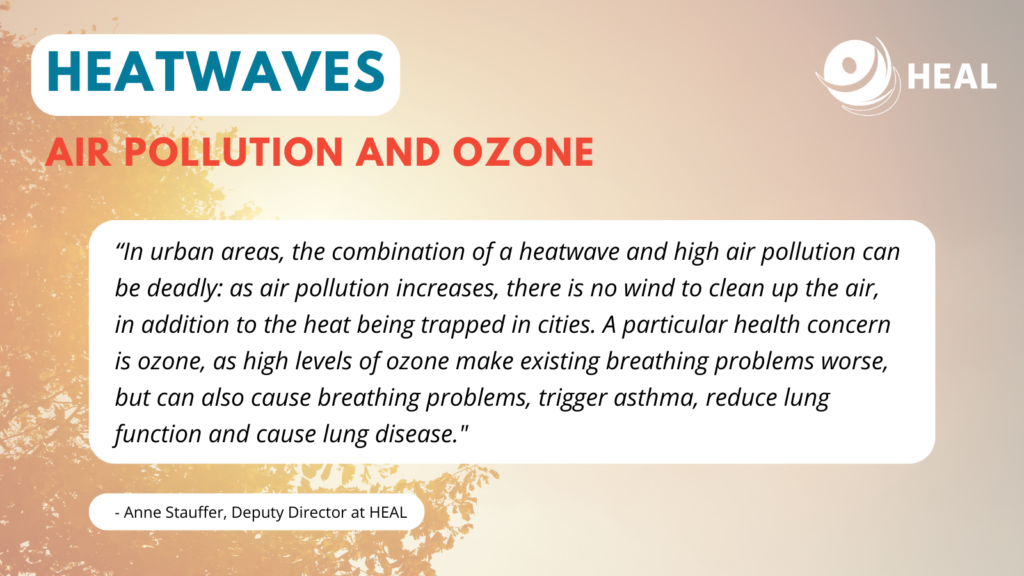The EU’s proposed 2040 climate target to reduce domestic emissions by 90% - while allowing up to 3% to be met through international carbon credits – risks undermining health protections. The Health and Environment Alliance calls on member states to strengthen their climate commitments in order to protect health, rather than delay and weaken overdue action.
Climate change leads to an increased frequency and severity of extreme weather events, including heatwaves. In June and July 2022, many European countries, such as Portugal, Spain, France and the UK, witnessed record temperatures above 40°C. Researchers have recently warned that Europe is the continent with the highest vulnerability for heat-related impacts of climate change. In 2019 alone, almost 345,000 people over 65 years old died after exposure to hot weather.

The World Meteorological Organization defines a heatwave as “five or more consecutive days during which the daily maximum temperature surpasses the average maximum temperature by 5°C (9°F) or more”. Heatwaves are one of several extreme weather events made worse by climate change and the rise in global temperatures – others being wildfires, heavy rainfall and associated flooding, and droughts.

Exposure to extreme heat can disrupt the body’s natural ability to regulate temperature, through thermoregulation mechanisms, and result in many illnesses, including heat cramps, heat exhaustion, heatstroke, and hyperthermia. It can worsen already existing health problems, and result in cardiovascular, respiratory, renal and nervous system diseases, sleep and mental health disorders, and death. Any person could be affected, whether they live in big cities, where the urban heat island effect causes the city temperatures to be higher than in surrounding rural and natural areas, or not.

However, some groups are more vulnerable, due to their age, health and socio-economic conditions:
- The elderly, pregnant women, infants and children, and people with pre-existing chronic diseases.
- Disabled people and those who live in poverty or social isolation.
- Athletes and people who work outdoors can be at higher risk as well.

Another adverse effect of hot weather is the increase in air pollution levels.
“In urban areas, the combination of a heatwave and high air pollution can be deadly: as air pollution increases, there is no wind to clean up the air, in addition to the heat being trapped in cities. A particular health concern is ozone, as high levels of ozone make existing breathing problems worse, but can also cause breathing problems, trigger asthma, reduce lung function and cause lung disease. But also major air pollution is released from the many wildfires which are currently raging across Europe,” explains Anne Stauffer, Deputy Director at HEAL.

Heatwaves are a distinct problem in many parts of the world, but also in Europe, with an increase in the frequency, duration and intensity of heatwaves in recent decades.
In 2003, more than 70,000 people died in Europe due to severe heatwaves. In 2019, nearly 345,000 people over 65 years old died after exposure to hot weather events. And scientific evidence shows that Europe is the region most vulnerable to the heat-related impacts of the climate emergency, due to its older and ageing population. With the accelerating climate emergency, the exposure to heatwaves will only increase in the coming years.

A report from the Intergovernmental Panel on Climate Change (IPCC) underlined that unless there are immediate, rapid and large-scale reductions in greenhouse gas emissions, we will be missing limiting warming to 1.5°C, as set in the landmark Paris Agreement. For the coming decades, the report projected an increase of climate changes in all regions: “For 1.5°C of global warming, there will be increasing heatwaves, longer warm seasons and shorter cold seasons. At 2°C of global warming, heat extremes would more often reach critical tolerance thresholds for agriculture and health”.
From a health perspective, the prescription is very clear: policy makers at global, EU, national and local level have to double down on climate action.
For the European Union, this includes increasing the climate ambition in the negotiations of the Fit for 55 package, so that we actually get a package that is fit for 1.5°C, as well as updating the EU’s clean air standards, to fully align them with WHO recommendations and the latest science by 2030.
And in view of the current EU energy developments with the war in Ukraine, policy makers should especially avoid false solutions, such as incentivising fossil gas and wood burning, which would continue to fuel air pollution and climate change.

![]()


